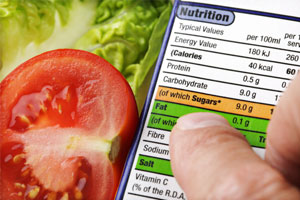AUSTRALIAN nutrition experts have called for renewed action on food labelling, saying an “evidence vacuum” has emerged on the best way to provide nutrition facts to the public.
Since the release of the federal government’s response to Dr Neal Blewett’s Labelling logic: Review of food labelling law and policy in December 2011, in which the recommendation of a “traffic-light” style labelling trial was rejected, the experts say there has been no action on food labelling. (1)
Professor Bruce Neal, director of the George Institute for Global Health and professor of medicine at the University of Sydney, said the time had come for the government to test labelling and packaging options with “robust research”.
“Where we are at is that the Australian food industry is moving forward with ‘front-of-pack’ labelling”, Professor Neal said.
Front-of-pack labelling differs from the standard nutrition labels, which currently appear on the back of product packaging. Rather than containing detailed nutritional data, front-of-pack labels are more visual, often using colour-coding, and are more intuitive, with many advocates believing they are therefore more consumer friendly.
“The challenge in this country is that the government and industry are making decisions on front-of-pack in an evidence vacuum. There is talk of an ‘energy star’ system, similar to what is on white goods, but there is no insight into how that performs in the real world”, Professor Neal said.
“Does it actually change what people buy? How does it compare to alternative methods like traffic-light labelling or daily intake information?”
Professor Neal was commenting in relation to a new study, published in the Journal of the Academy of Nutrition and Dietetics, that tested the efficacy of different nutrition label formats on consumers’ purchasing patterns. (2)
The study recruited more than 9000 participants to evaluate their ability to use, and their preference for, nine modified nutrition labels on food and a current label control. It found that using a single-serving or dual-column labelling approach might help consumers make healthier food choices.
Professor Neal said the study showed that it is possible to do robust research and Australia should follow suit.
“How we label food is important to how people understand their food. The endgame is does it change what people buy?
“At the moment the government is obsessed with making something happen, but it has to be something that works”, he said.
Although the government was due to decide on front-of-pack labelling late last year, it has deferred a decision for a few months, Professor Neal said. It would then be followed by a largely voluntary rollout program and a phase of evaluation.
“The next 18 to 24 months is a great opportunity for the government to actually test that system robustly”, he said.
Dr Tim Gill, scientific programs manager at the University of Sydney’s Institute of Obesity, Nutrition, Exercise and Eating Disorders, agreed that it was time for action on food labelling.
“The default position of government is to do nothing. They have to be pushed”, Dr Gill said.
“There is agreement from the food industry and public health officials that front-of-pack labelling — in which thumbprints indicate the proportion of the daily intake allowance for various ingredients — is of benefit to consumers.
“Traffic-light labelling works on a different principle — the amount of nutrients per 100 mg — but the red light worried people and that’s why the food industry baulked at it.
“To give the industry its due, they are starting to accept these things and there is movement in the ranks”, Dr Gill said.
“But if it is not to the advantage of their bottom line, they will drag their heels, and the government always wants consensus rather than showing leadership.”
The Department of Health and Ageing released a statement last December stating: “The collaborative process with key stakeholders [in front-of-pack labelling] will continue in order to develop the system by mid June 2013”. (3)
“This is an important project that aims to help consumers to make more informed food choices, while fostering a strong food industry”, the statement read.
– Cate Swannell
1. Review of Food Labelling Law and Policy
2. J Acad Nutr Diet 2013; 113: 241-250
3. Department of Health and Ageing: Legislative and Governance Forum on Food Regulation – Communique, 7 December 2013
Posted 29 January 2013

 more_vert
more_vert